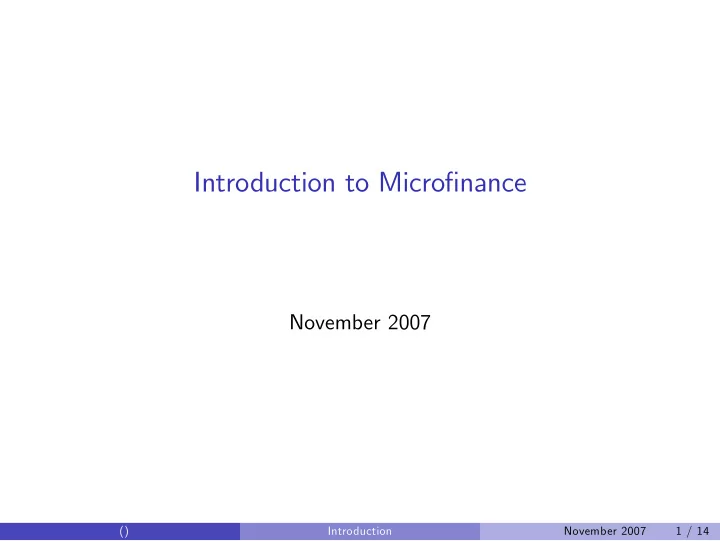

Introduction to Micro…nance November 2007 () Introduction November 2007 1 / 14
The Nature of Micro…nance Microcredit: collection of banking practices built around small loans, typically with no collateral Micro…nance: also includes e¤orts to , ! stimulate savings , ! provide insurance facilities , ! distribute and market clients’ output Programs exist worldwide , ! well-established programs in Bangladesh, Bolivia and Indonesia , ! new programs in Mexico, China and India , ! villages along the Amazon , ! inner-city Los Angeles , Toronto and Halifax Over 70 million clients (grown at 40% per year since 1997) () Introduction November 2007 2 / 14
The Grameen Bank: The Beginnings of Micro…nance Started by Mohammed Yunus (1976) with help from Bangladesh Bank Later helped by IFAD, Ford Foundation and several governments Basic group lending mechanism (Grameen I): , ! groups of 5 formed voluntarily , ! 2:2:1 staggering at 4-6 week intervals , ! cycle continues as long as loans are repaid , ! repayments made weekly in public , ! joint liability , ! progressive lending Initial analysis attributed success to role of "joint liability" More recent analysis emphasizes other aspects , ! dynamic incentives , ! high frequency repayment schedule , ! 95% female borrowers , ! current movement towards individual lending (Grameen II) () Introduction November 2007 3 / 14
Adverse Selection and Joint Liability Can group lending make it possible to "implicitly" charge safe borrowers lower interest rates and keep them in the market? Joint liability ) incentive for "assortative matching" () Introduction November 2007 4 / 14
Example: 2 member group One-period project requiring $1 investment Bank’s cost of $1 loan = k Fraction q of borrowers are "safe": gross return = y The remaining 1 � q are "risky": � ¯ y with prob. p Gross return = 0 with prob. 1 � p Indentical expected return: p ¯ y = y Borrowers know each others types, but lender doesn’t Assortative matching ) a fraction q of groups are (safe, safe) () Introduction November 2007 5 / 14
If both types of borrower are in the market, what is the break-even repayment, ˆ R b ? y > 2 ˆ , ! assume that ¯ y is large enough that ¯ R b Then the probability of repayment by a risky pair is 1 � ( 1 � p ) 2 g = 2 p � p 2 > p = since default occurs only if both members fail ) break even repayment: k ˆ R b = q + ( 1 � q ) g This must be less than the minimum repayment without group lending k R b = q + ( 1 � q ) p () Introduction November 2007 6 / 14
Implications In this case risky borrowers can repay more often , ! risk is transferred from bank to risky borrowers , ! allows bank to lower interest rate and still break-even , ! safe types may be lured back into the market () Introduction November 2007 7 / 14
Moral Hazard and Peer Monitoring Joint liability ) incentive for members to impose sanctions on each other to induce more e¤ort ) relaxes IC constraint ) more projects will be funded Can also help to overcome enforcement problem Relies heavily on use of "social sanctions" , ! is this realistic ? , ! is this a good thing ? () Introduction November 2007 8 / 14
Problems with Group Lending in Practice Mixed results across countries re‡ects di¤erences in trade-o¤ between bene…ts and costs Groups may be di¢cult/costly for borrowers to set up Attending group meetings can be costly in some cases; bene…cial in others Transfers risk from bank to borrowers Beyond a certain lending scale, individual contracts may be preferred Social sanctions for default often seem too harsh and/or not credible , ! what if the defaulter has trouble through no fault of her own? , ! punishment imposes a "deadweight loss" () Introduction November 2007 9 / 14
Beyond Group Lending Emerging view: joint liability is often not the main key to success Shift toward individual lending for the "not so poor" Grameen II proposal Emphasis on dynamic incentives to induce repayment , ! e.g. progressive lending , ! a key element of Grameen bank lending () Introduction November 2007 10 / 14
Progressive Lending (two period example) Invest L to get output y = AL > L Let δ = discount factor Let v = probability of being re…nanced despite default gross borrowing rate = R IC constraint for …xed L AL � RL + δ AL � AL + δ vAL ) lender’s maximum repayment: R � = δ A ( 1 � v ) () Introduction November 2007 11 / 14
Suppose loan grow by a factor λ > 1 between periods IC constraint AL � RL + δλ AL � AL + δ vAL ) maximum repayment R �� = δ A ( λ � v ) > R � If R � < r < R �� , loans will be made that previously weren’t () Introduction November 2007 12 / 14
Implications Progressive lending can help to relax borrowing constraint But, in a multi-period context, borrower may choose to default once loan size becomes large enough () Introduction November 2007 13 / 14
Privatization of Micro…nance ? Presented as a market-based strategy for poverty reduction, but continues to be heavily subsidized Intended strategy: subsidies initially, then operate without them once scale economies and experience drive down costs Need to attract savings, issue bonds or obtain commerical funds In July 2002 Financiera Compartamos (ACCION) issued a 100 million peso bond , ! to get A+ rating from S&P, lending rates exceed 110% Why worry about high rates if enough borrowers can pay them? , ! complementary inputs , ! increasing returns at low levels To serve the poorest, subsidies may be essential () Introduction November 2007 14 / 14
Recommend
More recommend